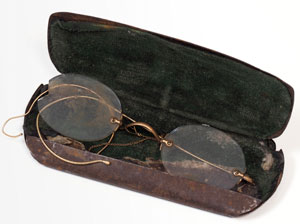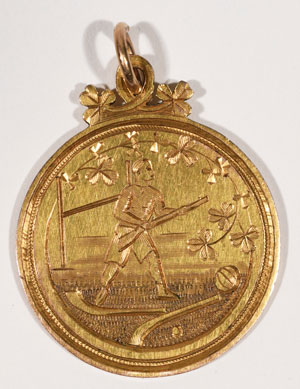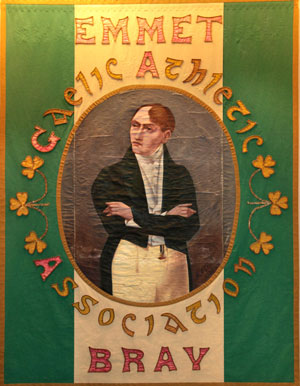GAA MUSEUM, CROKE PARK
Published in Issue 6 (November/December 2022), Reviews, Volume 30By Donal Fallon

Above: The glasses of Annie Burke, damaged when she came to the assistance of Tipperary player Michael Hogan in Croke Park on Bloody Sunday, 21 November 1920.
In November 2021, at the end of a second difficult year for heritage sites, Fáilte Ireland announced the awarding of funding to ten museums and cultural institutions in the capital. One of those recipients, the GAA Museum, has benefited enormously from this and earlier funding. Significantly altered since Tony Canavan’s visit four years ago (HI 26.6, Nov./Dec. 2018, Museum Eye), the museum today feels fresher and modernised.
The story of the Gaelic Athletic Association has many strands. The work of sports historians in recent years, in particular that of Paul Rouse, has done much to challenge the perception that the body was primarily one focused on matters political, instead restoring perspective on the role of recreation. The GAA’s success, Rouse notes, was primarily ‘the story of the triumph of play’.

Above: Rifle, football and hurl—one of the medals presented to players of Dublin and Tipperary at a match in Croke Park on the first anniversary of Bloody Sunday.
Yet politics was still, at an organisational level, a deeply important dimension of the tale of the development of the GAA. For men like Michael Cusack, who founded the Metropolitan Hurling Club in Dublin ‘to test the pulse of the nation’, matters sporting and political were inseparable. There were others who recognised the political potential of the body, a Dublin Castle report warning that ‘the Fenians worked steadily in a stealthy way … to gain … as large a section as possible’. Outside the GAA Museum, Paul Ferriter’s impressive statue of Cusack stands defiantly, blackthorn stick in hand. In a place where family tradition is everything, it is fitting that the sculptor’s father, Seán Ferriter, is a highly esteemed former Gaelic footballer.
For sports museums, the balance of sport and broader society is key. A visitor to Manchester’s impressive National Football Museum in recent years could encounter temporary exhibitions as diverse as ‘Football and the Fine Arts’ and ‘Crossing the Line’, dedicated to exploring women and Association Football. Visiting the renovated GAA Museum, it is clear that the intention is to examine the organisation and its history in a multifaceted way, and in a way that also touches on broader Irish history. The impacts of Irish nationalism on the organisation are examined (and, indeed, the impacts of the organisation on Irish nationalism), but this is also a museum that prioritises the story of Gaelic games themselves. There are surprising strands, too, with much that will appeal to those interested in design history and material culture.
On entering the museum, the first historic artefact that we encounter is a turnstile, a reminder of the development of the site itself. Once the City and Suburban Racecourse, the Jones’s Road venue was utilised for just about every sport imaginable before its acquisition by Frank B. Dineen of the GAA for the sum of £3,250 in the early twentieth century. An aging turnstile reminds us how gradual was the development of what we now know as an 82,300-capacity venue. A new introductory video explains the games themselves, how they are played and their origin.
Heritage Council funding has allowed the museum to bring professional conservation expertise to one of its most significant items. Believed to be the earliest surviving GAA club banner, the Bray Emmets’ standard belonged to a club founded in 1885, just a year on from the establishment of the GAA itself, though the banner may be later, from the time of widespread commemoration of the United Irishmen in the late 1890s. The banner shows Emmet, amidst shamrocks and design typical of the late nineteenth and early twentieth centuries in cultural nationalism. The naming of GAA clubs after figures like Emmet was commonplace, but others looked abroad for inspiration. In 1899 a team named the Irish Brigade Transvaal was welcomed into the association in Kerry, while others named clubs after Kruger, De Wet and other Boer heroes during the Second Boer War.
On a completely revamped new ground floor, space is utilised well, giving newly displayed artefacts room to be appreciated. Since renovation, there is also greater focus on audio-visual material and exhibitions, although this remains primarily a museum experience focused on physical artefacts and their power. Reflecting the shift towards a social history approach, something visible across all museum settings in Ireland, many of the items are surprisingly personal. Within an exhibition space dedicated to the centenary of Bloody Sunday we see a pair of glasses belonging to a young spectator, Annie Burke. Annie had attended the game with friends and rushed towards Tipperary player Michael Hogan after he was shot. Amidst the chaos, her spectacles were damaged. As we hear the testimony of those who were present that day read by actors and look at the damaged glasses, we see how good use of primary source material like testimonies can bring a seemingly everyday object to life.
Near Annie Burke’s glasses, another Bloody Sunday artefact says much about the meaning of that event in the broader period. On the first anniversary of the massacre, the footballers of Tipperary and Dublin met again in Croke Park during a commemorative tournament, gathering after the game at the spot where Michael Hogan had been fatally shot. The players were presented with medals from the Irish National Assurance Company. Significantly, the medal (one of which sold at auction at Fonsie Mealy’s auction house for €18,000 in 2020) shows a Gaelic athlete clutching a rifle, football and hurl alongside him.
While the ground-level experience has been transformed, those visiting the GAA Museum with children will be glad to hear that the hands-on dimension of the experience, contained within the Interactive Games Zone, remains. The chance to try your hand at a sport after such an in-depth explanation of its origins is unique in a museum setting.
All in all, the experience of the GAA Museum today is proof of the need for such spaces to adapt. With a much greater emphasis on the social history of the game, the GAA Museum is a 21st-century tribute to a culture that first found expression in very different times.
Donal Fallon is a historian and the author of Three Castles Burning: a history of Dublin in twelve streets (New Island, 2022).

















